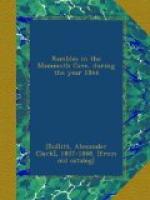[Illustration: ENTRANCE TO THE GOTHIC AVENUE. On Stone by T. Campbell Bauer & Teschemacher’s Lith.]
While examining the old saltpetre works, the guide left us without our being aware of it, but casting our eyes around we perceived him standing some forty feet above, on the projection of a huge rock, or tower, which commands a view of the grand gallery to a great extent both up and down.
Leaving the Main Cave and ascending a flight of stairs twenty or thirty feet, we entered the Gothic Avenue, so named from the Gothic appearance of some of its compartments. This avenue is about forty feet wide, fifteen feet high and two miles long. The ceiling looks in many places as smooth and white as though it had been under the trowel of the most skilful plasterer. A good road has been made throughout this cave, and such is the temperature and purity of its atmosphere, that every visitor must experience their salutary influences.
In a recess on the left hand elevated a few feet above the floor and about fifty feet from the head of the stairs leading up from the Main Avenue, two mummies long since taken away, were to be seen in 1813. They were in good preservation; one was a female with her extensive wardrobe placed before her. The removal of those mummies from the place in which they were found can be viewed as little less than sacrilege. There they had been, perhaps for centuries, and there they ought to have been left. What has become of them I know not. One of them, it is said, was lost in the burning of the Cincinnati museum. The wardrobe of the female was given to a Mr. Ward, of Massachusetts, who I believe presented it to the British Museum.
Two of the miners found a mummy in Audubon Avenue, in 1814. With a view to conceal it for a time, they placed large stones over it, and marked the walls about the spot so that they might find it at some future period; this however, they were never able to effect. In 1840, the present hotel keeper Mr. Miller, learning the above facts, went in search of the place designated, taking with him very many lights, and found the marks on the walls, and near to them the mummy. It was, however, so much injured and broken to pieces by the heavy weights which had been placed upon it, as to be of little interest or value. I have no doubt, that if proper efforts were made, mummies and other objects of curiosity might be found, which would tend to throw light on the early history of the first inhabitants of this continent.
Believing, that whatever may relate to these mummies cannot fail to interest, I will extract from the recently published narrative of a highly scientific gentleman of New York, himself one of the early visitors to the Cave.
“On my first visit to the Mammoth Cave in 1813, I saw a relic of ancient times, which requires a minute description. This description is from a memorandum made in the Cave at the time.




